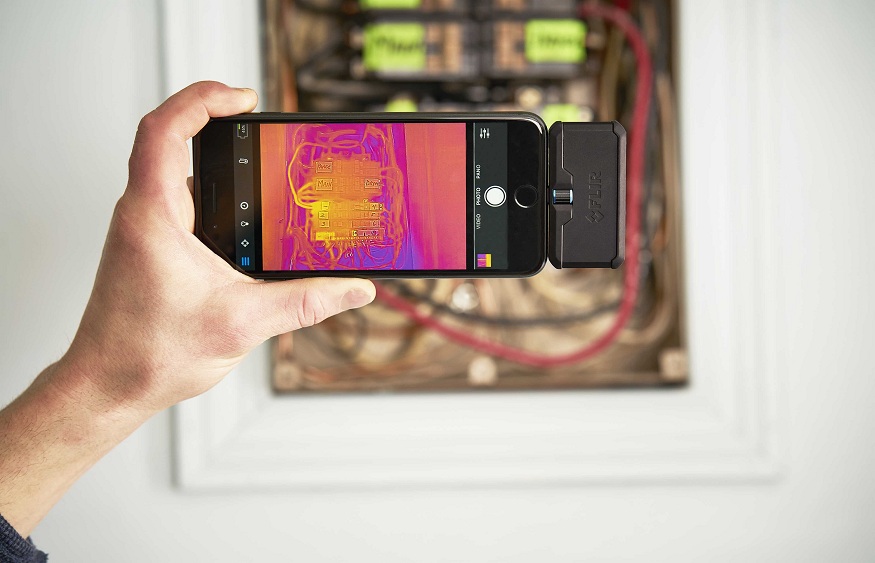Thermal imaging technology has come a long way, and one of the most exciting developments in recent years is the integration of thermal cameras into smartphones. These innovative devices allow users to see and capture heat signatures, which have a wide range of applications, from home improvement and outdoor activities to industrial and professional use. This article will explore some essential things you need to know about Smartphone thermal cameras.
1. What Is a Smartphone Thermal Camera?
A Smartphone thermal camera is a specialized camera integrated into a standard Smartphone that utilizes thermal imaging technology. Unlike regular Smartphone cameras, which capture visible light, Smartphone thermal cameras can detect and capture heat signatures by measuring the infrared radiation emitted by objects. The core components of a Smartphone thermal camera typically include a microbolometer or similar sensor. This sensor can sense temperature differences in the environment and convert them into a visual representation on the Smartphone’s screen. The resulting image often displays varying temperatures using different colors or gradients, with warmer areas appearing as brighter or distinct colors and more relaxed areas as darker shades.
2. How Do Smartphone Thermal Cameras Work?
Smartphone thermal cameras detect infrared radiation emitted by objects. Then, it converts it into a visible image. These cameras use microbolometers or similar sensors to capture temperature differences and create a thermal image. The idea is then superimposed on the regular camera viewfinder, allowing you to simultaneously see the thermal and visible spectrum.
3. Applications of Smartphone Thermal Cameras
Smartphone thermal cameras have a wide range of applications across various industries and everyday scenarios due to their ability to capture heat signatures and temperature variations. Here are some of the critical applications of Smartphone thermal cameras:
4. Home Improvement and Energy Efficiency
Detecting Energy Leaks: Identify heat or cold air leaks in buildings, helping homeowners improve energy efficiency and reduce heating and cooling costs.
Inspecting Insulation: Evaluate the quality of insulation in walls and ceilings to ensure proper thermal isolation.
Identifying Electrical Issues: Detect overheating electrical connections or malfunctioning components, preventing potential electrical hazards.
Outdoor Activities: Wildlife Observation: Observe animals and wildlife in the dark or during low-light conditions, enabling wildlife enthusiasts and researchers to study nocturnal creatures.
Search and Rescue: Aid search and rescue teams locate missing persons or survivors, especially in remote or challenging environments.
Navigation: Enhance navigation in low-visibility or dense forests by identifying temperature differences and landmarks.
Industrial Inspections: Equipment Monitoring: Inspect machinery, motors, and electrical systems for signs of overheating or malfunction, preventing costly downtime and repairs.
Faulty Wiring Detection: Identify overheating or faulty wiring in industrial settings, reducing the risk of electrical fires.
Quality Control: Ensure the quality of manufactured products by detecting defects or irregularities in heat distribution.
Firefighting: Firefighters use Smartphone thermal cameras to locate victims in smoke-filled environments and identify hotspots during firefighting operations.
Law Enforcement: Assist law enforcement officers in locating suspects, detecting hidden objects, and conducting surveillance, even in low-light conditions.
Building Inspections: Inspections can more efficiently identify structural issues, insulation problems, and electrical faults.
HVAC and Plumbing: Diagnose HVAC Problems: Identify clogs or leaks in heating and cooling systems, ensuring proper performance and efficiency.
Plumbing Inspections: Locate hidden water leaks, blocked pipes, or pipe damage within walls or under floors.
Agriculture: Crop Health Assessment: Monitor crop health by detecting temperature variations, allowing farmers to identify potential issues early. Optimizes irrigation practices by identifying areas with varying moisture levels in the soil.
DIY Projects and Building Construction: Aid DIY enthusiasts in various home improvement projects by spotting insulation problems, water leaks, or electrical issues.
Construction: Assist construction workers and contractors in quality control, identifying thermal anomalies in new building projects.
Thermal Surveys: Smartphone thermal cameras are versatile tools that can be used in numerous scenarios, making them valuable for professionals and individuals interested in enhancing their understanding of temperature variations in the world around them.
5. Integration with Smartphone Features
Most Smartphone thermal cameras superimpose the thermal image on the regular camera viewfinder. This allows users to see the thermal and visible spectra simultaneously, making identifying objects and their temperature differences easier. Smartphone thermal cameras typically allow users to capture and save thermal images. Some models also enable users to record videos in thermal mode, which can be valuable for documenting temperature variations over time. Specific models offer time-lapse functionality, allowing the users to record thermal images at set intervals. This is useful for monitoring changes in temperature or environmental conditions over an extended period.
6. Compatibility and Operating Systems
Some Smartphone models with integrated thermal cameras are designed to work seamlessly with Apple’s iOS operating system, which is used in iPhones and iPads. These devices will have dedicated apps on the Apple App Store to support the thermal camera’s functionality. Other Smartphone models are designed to work with the Android operating system, which many manufacturers use, including Samsung, Google, LG, and many others. These devices will have dedicated apps on the Google Play Store to support the thermal camera’s functionality.
7. Price and Affordability
The cost of Smartphone thermal cameras can vary widely. Entry-level models can be affordable, while more advanced models with higher-resolution sensors and additional features may have a higher price tag. Consider your budget and the intended use when making a purchase.
8. Limitations and Considerations
Smartphone thermal cameras have some limitations. They may not be as accurate as dedicated professional thermal imaging cameras. Additionally, their performance can be affected by factors like ambient temperature, distance, and material composition. It’s essential to understand these limitations and use the device accordingly.
9. Third-Party Apps and Accessories
Some smartphones support third-party thermal imaging apps and accessories. These apps can enhance the functionality of your thermal camera, providing additional features and capabilities. Look for compatible apps and accessories to extend the utility of your device.
10.Privacy and Ethical Considerations
Using a Smartphone thermal camera can raise privacy and ethical concerns. Ensure you use the technology responsibly and respect privacy laws and regulations. Be aware of the ethical considerations in various situations, such as using the camera in public spaces or private property.
Smartphone thermal cameras are a fascinating and versatile addition to mobile technology. They offer various applications, from home improvement and outdoor activities to industrial and professional use. When considering a Smartphone with thermal imaging capabilities, it’s essential to understand how it works, its applications, limitations, and ethical considerations. With the right knowledge and proper use, Smartphone thermal cameras can be valuable tools in various aspects of our lives.

